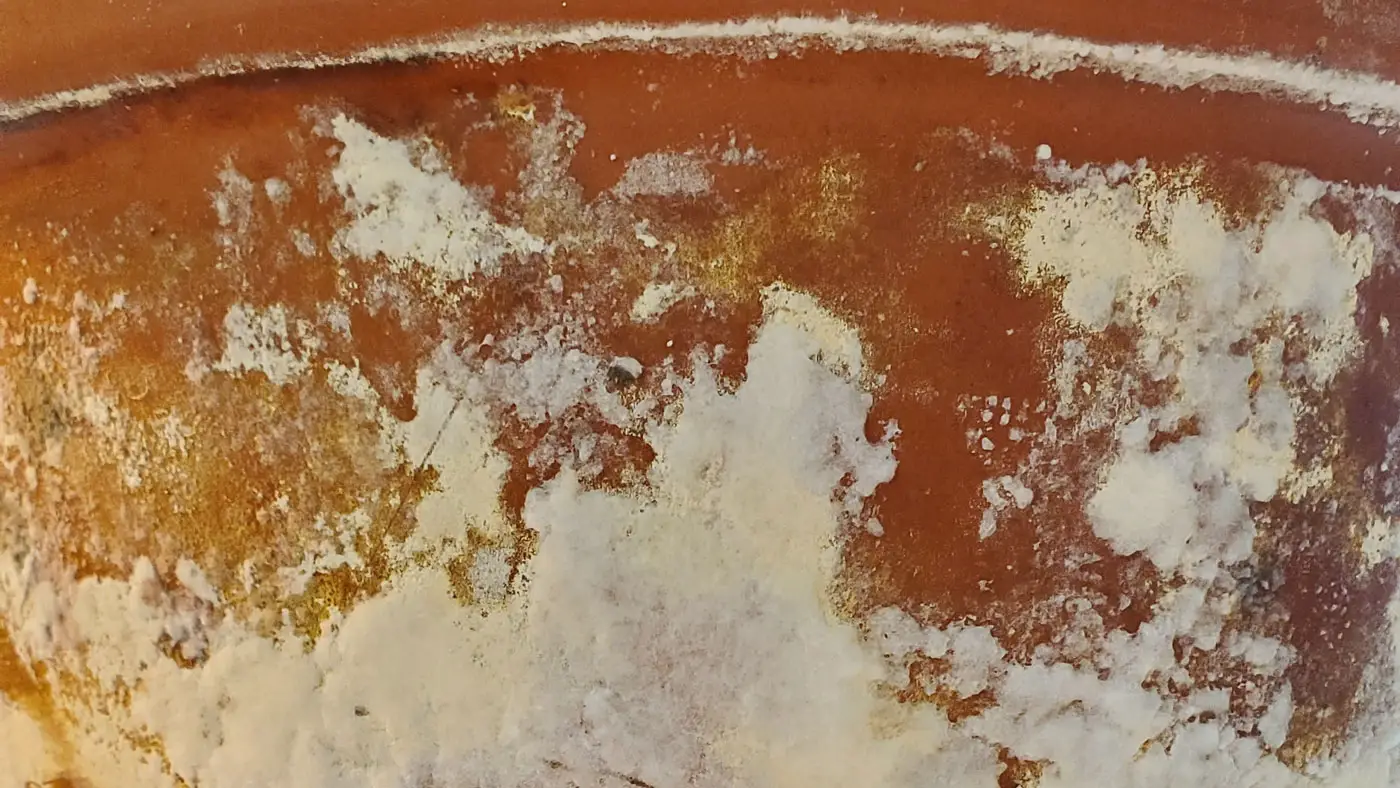
Mold readily grows in terracotta pots as the pots provide the perfect environment for it to grow. Terracotta absorbs moisture from the soil, the pores are moist almost all the time so they provide excellent conditions for the fungus to grow. If the pots are in a darker area, in high humidity and with little airflow, the fungus grows even faster. You will either see white fuzzy mold or black mold around the rim or on the sides of pots. Watering plants too frequently will also contribute, as will keeping plants in low light. With lower light, plants photosynthesize less, absorb less water from the soil, leaving the soil and the pot moist for longer periods of time.
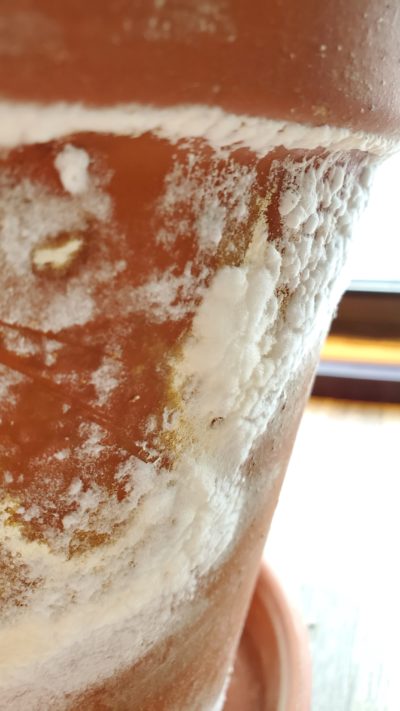
How do i distinguish between mold and mineral deposits?
If you see fuzzy growth, you have mold. If you lightly scrape the mold with your finger, it will usually come off easily. Mineral deposits will not. Watch the Instagram video a few paragraphs below for a demonstration of the difference between mineral deposits and mold.
Can I leave the mold on terracotta? Is it harmful?
Mold on the outside of pots will not harm your plants. However, mold can be very harmful to human health, especially with prolonged exposure. Mold produces spores which can easily be inhaled. Some people are sensitive to mold and will experience stuffy nose, itchy eyes or skin, while people with allergies or asthma or compromised immune systems may experience more intense reactions. Make sure to remove all mold as soon as you notice it.
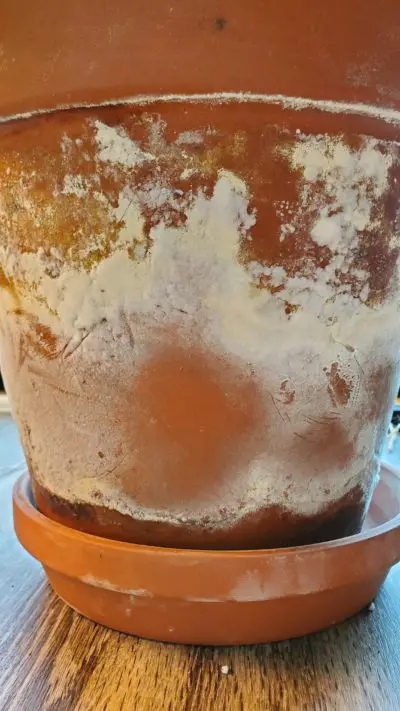
Cleaning method 1- using Hydrogen Peroxide – without taking the plant out
The first and easiest method to kill mold is by using hydrogen peroxide. Pour 3% hydrogen peroxide in a spray bottle and spray the outside of your pots, where the mold is located.
Let it sit for a few minutes. You will notice hydrogen peroxide sizzling as it’s interacting with the mold. Wash the outside of the pots with water to physically remove as much of the mold as you can. If needed, scrub the outside of terracotta with a brush. At the end, I like to spray a bit of hydrogen peroxide to the outside of the pots.
Check out this video of the whole cleaning procedure.
Make sure to not expose hydrogen peroxide to light as it will become ineffective and will not kill the mold.
A bleach solution is also an effective way to kill the mold. Mix one part bleach in 20 parts of water and put in a spray bottle. Since bleach is very strong and toxic, before applying I suggest taking the whole plant with the rootball out of the pot. Spray the outside surface of terracotta with bleach and scrub.
After removing the mold, soak the pot in clean water to remove the remaining bleach. Repeat 2-3 times, to make sure you removed all bleach. Let the pot air out for a few days, so the smell of bleach is completely gone before putting the plant back in. You can keep the plant in a temporary pot in the meantime.
A great way to prevent mildew from growing is to provide direct sun to the pots/plants that can handle it. Exposure to direct sun will kill the mold. Increased air circulation (you can use a fan) will also help. I also like to occasionally treat the outside of all my of terracotta pots with hydrogen peroxide.
This way I know I’ll be safe for a while.
Yours Truly,


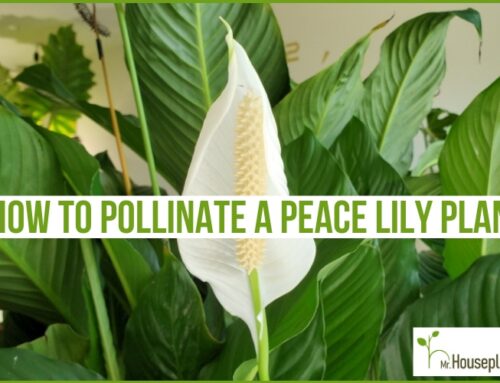
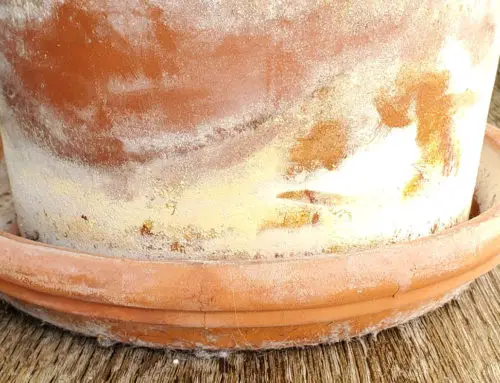

My flower pots need cleaning but plants cannot be removed. The terracotta pots are large and have turned black.The plants are healthy. Would it be safe to use Dawn instead of bleach. Will either kill my plants. I use bleach to treat my sidewalks that are covered in black mold but don’t want to killed my mature plants in the pots. I use a lot of palms and catcus plants. Thank you for an answer.
I would recommend using hydrogen peroxide instead of bleach. Just spray the outside of the pots and wipe them off
Should I mix the hydrogen peroxide with water or just use straight hydrogen peroxide on my terracotta plant with my aloe vera plants on the inside
If you buy a 3% hydrogen peroxide, you can use it on the outside of the pot right away, no need to mix it with water. If you buy a higher concentration, then I suggest you dilute it to 3% strength :)
Hi. My pots have the black type, not white as you demonstrated in your video. Does hydrogen peroxide work on black molds, too? Thanks.
Hi Roberta, I’ve had both black and white mold on my terracotta post and I successfully removed them both with hydrogen peroxide.
Hi,
How long does the hydrogen peroxide works? Should I keep spraying the outside part of my terracotta pots regularly to prevent the molds from coming back?
Hi Celeste, that is very individual and will be different from home to home and plant to plant. It could be a few days, a few weeks or a few months.
If the plant can handle direct sun, you can put it in a spot with direct sun, that will kill the mold on the outside of the pot. Or if it can’t handle it, there are a few other things you can do:
-keep spraying with peroxide
-increase the amount of light for the plant, so the soil dries out faster
-reduce humidity by using a dehumidifier, this also makes the soil dry out faster
-reduce the amount of water when watering or reduce the frequency of watering, if the plant can handle it
-repot into a better draining potting mix with more inorganic matter
Hope this helps :)
Thank you for this info, I will definitely try hydrogen peroxide on the new terracotta pots I recently used to repot a few plants that have just started to develop the white mold.
On a semi-related topic, what about mold on soil? I recent got a maidenhead fern (I know, it will probably perish soon), and a few days after I did a thorough watering, fuzzy mold developed on the soil. The soil seemed to be fairly well draining, so not sure what’s happening. I’ve had house plants for years but I’m fairly new to learning about how to take good care of them :) – thanks for reading!
Hi Leslie,
Thank you for your message! Regarding mold on soil, to prevent it from forming, you want the soil to stay wet shorter/dry out faster and there are a few things you can do to make this happen:
-increase the amount of light (I hope you have a light meter as that is the only reliable way to measure light :) More light=more photosynthesis=plant pulls more water from soil=soil stays wet shorter=less chance of mold
-increase air circulation – you can add a fan or keep the plant next to an open window if it’s warm enough outside
-amend the potting mix – if you’re using a mix straight out of the bag, most potting mixes are not well-draining enough, I would say over 90% of them. A little bit of perlite they add doesn’t do much, they should have at least 20-30% perlite, in some cases even more.
You can also spray the top layer of soil with hydrogen peroxide. Or just remove the top layer of soil.
Mold on soil is generally not something you need to worry about. It’s harmless, but it can point to the fact that the soil is staying wet for too long, which can lead to root rot, which is why it’s good to do the things I mentioned, to have the soil dry out faster.
Hope this helps! :)
hi thanks for the information we will definitely use 3% peroxide for the outside of the pots, but we also have mold growing on the inner rim of our pots.
should we remove our plants, use bleach and repot them in new soil to remove all of the mold?
Hi Tommy, I would suggest just spraying the inner rim with hydrogen peroxide as it’s safe for the plant, unlike bleach. No need to take the whole plant out.
Focus on providing more air circulation and more light, so the soil doesn’t stay wet as long. And lower humidity, if possible. A dehumidifier can help.
Thanks for this information! If I can, I’d like to get some clarity from you. The white coloration on my terracotta pot is easy to remove with a good swipe of my finger, but it is not fuzzy at all. The residue it leaves on my finger feels sappy, almost resin-like but not as sticky. So – do I have white mold or normal buildup? If you need any other identifying information, please let me know. Thank you!
Hi Kate, I’m afraid I can’t say for sure without a photo. If it’s easy to wipe off with a finger, I am more inclined to say mold, but sometimes you can remove a part of mineral deposits by wipping. Feel free to send me a photo on Instagram
Hey! what about mold that has spread to the inside of the pot? would it be best to fully repot the plant?
Hi, I would be more worried about the conditions that are leading to the mold forming. If you repot into a similar potting mix and keep the same light, it’s likely to show up again. Focus on increasing light, reducing watering and if you repot, make a better draining, more porous potting mix.